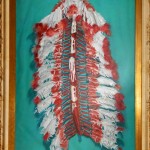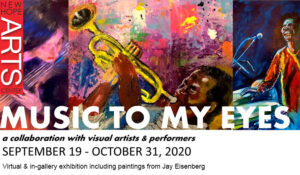 [br] [br] “Red, White, and Blue Indian”, Pastel on paper, hand made frame, applied fringe cut chamois, 73″h x 48″w
[br] [br] “Red, White, and Blue Indian”, Pastel on paper, hand made frame, applied fringe cut chamois, 73″h x 48″w
My life long love, admiration and sadness, related to Native American life, was the inspiration for this piece. Everywhere I ever lived had the footprint of this lost, humiliated diaspora of the American Indian. The evidence of the American Indian / Native American now, was local. From NYC where I lived until the age of eight and then to the suburbs where I grew up, the names of tribes, individual chiefs, rivers, trees, plants, rocks, haircuts, you name it, were everywhere. So for me as a young child living in the borough of “The Bronx” (Dutch of course), I was either reading about the Dutch, the Indians, or the English. All of which were to influence me later in life, having lived in Amsterdam and many years later, in London.
At one time in Mt. Vernon, NY., where I lived for two years, I lived on “Tecumseh” Ave., named after a Shawnee Chief. My family then moved to “Monsey”, NY., also the name of an Indian tribe. There I played in the undeveloped woods and playing Indian took little stretch of ones imagination to act and feel like an Indian. Getting home and then turning on the TV to watch “The Lone Ranger” was all I needed to suffice my hero worship, watching Tonto, with whom the actor, Jay Silverheels, I shared a first name.
As my concept about employing body coverings, fashion as art/art as fashion, idea developed, the headdress as a great American icon was simply most obvious and apparent.
Using pastel seemed the most appropriate to try to create the billowing softness of the feathers. Degas and his mastery of the medium was inspirational although technically, the other side of the moon from what I was trying to accomplish. Well of a hundred hours later and the work was finally done.
The encapsulation idea of the frame now became one more of theme than material, but it seemed to work over and over again and as integral part of the piece. Here the fringed chamois was akin to what the Natives American often use for their clothing.
The red, white, and blue, in this case turquoise, also carried the Americana theme to its conclusion. The blue was to emphasize a consideration to the word blue as in feeling blue or having the “blues”, and so often the state of affairs of our Native Americans with so much prejudice perpetrated against them.
Sadly and often, much like this headdress, their artifacts and art are collected, cherished and venerated. Meanwhile, Native Americans and their children are neglected.



